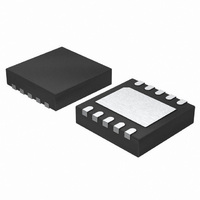ISL6292CCR3Z Intersil, ISL6292CCR3Z Datasheet - Page 6

ISL6292CCR3Z
Manufacturer Part Number
ISL6292CCR3Z
Description
IC CHARGER LI-ION POLYMER 10-DFN
Manufacturer
Intersil
Type
Battery Chargerr
Specifications of ISL6292CCR3Z
Function
Charge Management
Battery Type
Lithium-Ion (Li-Ion), Lithium-Polymer (Li-Pol)
Voltage - Supply
4.3 V ~ 6.5 V
Operating Temperature
-20°C ~ 70°C
Mounting Type
Surface Mount
Package / Case
10-VFDFN Exposed Pad
Output Current
0.4 to 1.5A
Output Voltage
4.2V
Operating Supply Voltage (min)
4.3V
Operating Supply Voltage (max)
6.5V
Operating Temp Range
-20C to 70C
Package Type
DFN
Mounting
Surface Mount
Pin Count
10
Operating Temperature Classification
Commercial
Lead Free Status / RoHS Status
Lead free / RoHS Compliant
Available stocks
Company
Part Number
Manufacturer
Quantity
Price
Theory of Operation
The ISL6292C is an integrated charger for single-cell Li-ion
or Li-polymer batteries. The ISL6292C functions as a
traditional linear charger when powered with a voltage-
source adapter. When powered with a current-limited
adapter, the charger minimizes the thermal dissipation
commonly seen in traditional linear chargers.
As a linear charger, the ISL6292C charges a battery in the
popular constant current (CC) and constant voltage (CV)
profile. The constant charge current I
up to 1.5A with an external resistor. The charge voltage V
has 1% accuracy over the entire recommended operating
condition range. The charger always preconditions the
battery with 10% of the programmed current at the beginning
of a charge cycle, until the battery voltage is verified to be
above the minimum fast charge voltage, V
current preconditioning charge mode is named trickle mode.
The verification takes 15 cycles of an internal oscillator
whose period is programmable with the timing capacitor. A
thermal-foldback feature removes the thermal concern
typically seen in linear chargers. The charger reduces the
charge current automatically as the IC internal temperature
rises above 100°C to prevent further temperature rise. The
thermal-foldback feature guarantees safe operation when
the printed circuit board (PCB) is space limited for thermal
dissipation.
The charger offers a safety timer for setting the fast charge
time (TIMEOUT) limit to prevent charging a dead battery for
an extensively long time. The trickle mode is limited to 1/8 of
TIMEOUT.
The charger automatically re-charges the battery when the
battery voltage drops below a recharge threshold. When the
wall adapter is not present, the ISL6292C draws less than
1
µ
A current from the battery.
FIGURE 3. TYPICAL CHARGE CURVES USING A
I
REF
V
V
I
V
REF
/10
MIN
P
P
P
CH
IN
1
2
3
Trickle
Mode
Input Voltage
CONSTANT-VOLTAGE ADAPTER
Constant Current
Mode
TIMEOUT
6
Constant Voltage
REF
Power Dissipation
Mode
Battery Voltage
Charge Current
is programmable
MIN
. This low-
Inhibit
CH
ISL6292C
Three indication pins are available from the charger to
indicate the charge status. The V2P8 outputs a 2.8V dc
voltage when the input voltage is above the power-on reset
(POR) level and can be used as the power-present
indication. This pin is capable of sourcing a 2mA current, so
it can also be used to bias external circuits.
The STATUS pin is an open-drain logic output that turns
LOW at the beginning of a charge cycle until the end-of-
charge (EOC) condition is qualified. The EOC condition is:
the battery voltage rises above the recharge threshold and
the charge current falls below a user-programmable EOC
current threshold. Once the EOC condition is qualified, the
STATUS output rises to HIGH and is latched. The latch is
released at the beginning of a charge or re-charge cycle.
The open-drain FAULT pin turns low when a charge time
fault occurs or when the IREF pin is pulled below 0.35V or
above 1.4V.
Figure 3 shows the typical charge curves in a traditional
linear charger powered with a constant-voltage adapter.
From the top to bottom, the curves represent the constant
input voltage, the battery voltage, the charge current and the
power dissipation in the charger. The power dissipation P
is given by the following equation:
where I
dissipation occurs during the beginning of the CC mode. The
maximum power the IC is capable of dissipating is
dependent on the thermal impedance of the printed-circuit
board (PCB). Figure 3 shows, with dotted lines, two cases
that the charge currents are limited by the maximum power
dissipation capability due to the thermal foldback.
P
CH
I
FIGURE 4. TYPICAL CHARGE CURVES USING A CURRENT-
REF
V
V
I
=
I
V
REF
/10
MIN
LIM
P
P
CH
CHARGE
IN
1
2
(
V
IN
Trickle
Mode
–
LIMITED ADAPTER
V
BAT
is the charge current. The maximum power
Constant Current
Input Voltage
) I
⋅
CHARGE
Mode
TIMEOUT
Constant Voltage
Power Dissipation
Mode
Battery Voltage
Charge Current
Inhibit
July 22, 2005
FN9133.2
(EQ. 1)
CH














